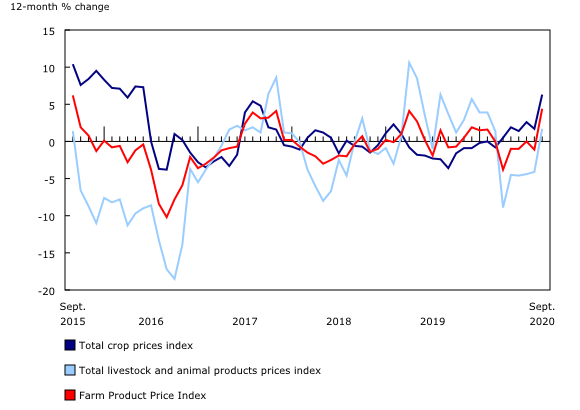Farm Product Price Index, September 2020
Archived Content
Information identified as archived is provided for reference, research or recordkeeping purposes. It is not subject to the Government of Canada Web Standards and has not been altered or updated since it was archived. Please "contact us" to request a format other than those available.
Released: 2020-12-02
The Farm Product Price Index increased 4.4% in September compared with the same month a year earlier, as a result of higher prices for most major commodity groups.
Following year-over-year increases in the first quarter of 2020, the index declined in four of the five months starting in April as the COVID-19 pandemic began to affect the red meat sector.
The crops index was responsible for most of the increase in September, up 6.3% from September 2019, which was driven by higher prices for wheat, oilseeds and specialty crops. Good harvest conditions and greater availability of rail transport for grains and oilseeds boosted crop marketings this September compared with last year.
Higher lentil prices continue to be a main driver behind the 24.7% increase in the specialty crops index, closely followed by increased dry pea prices. Continued strong lentil demand from India and Turkey and an early harvest pushed exports in the first few months of the 2020/2021 crop year to almost 13% above last year's record crop year exports.
The oilseed index rose 8.9% compared with September 2019 as canola, soybean and flax prices all increased. Prices have been supported by tighter world oilseed supplies going into the 2020/2021 crop year and strong world oilseed demand. In September, the United States Department of Agriculture reported reduced soybean yield forecasts for 2020/2021 and robust export commitments for soybeans early this crop year.
To a lesser extent, a 2.7% increase in the grains index also contributed to the gain in the crop index, mainly as a result of higher wheat prices. Both durum and non-durum wheat prices increased compared with the same time last year, in the wake of a higher quality crop harvested this fall and strong demand.
Higher prices for hogs and the supply-managed commodities were the main reason for the 1.7% increase in the livestock and animal products index compared with the same period last year.
Hog prices rose 7.0% in September compared with September 2019, the first year-over-year monthly increase since declining in April when the pandemic disrupted meatpacking operations. Capacity improved during the third quarter, keeping processing levels for the first three quarters of 2020 well above those of the previous year in both Canada and the United States, as strong export demand for pork continued.
Price increases for the supply-managed commodities ranged from 0.2% for poultry to 2.7% for eggs.
Moderating the increase in the livestock and animal products index was a 0.5% drop in the cattle and calves index, the seventh consecutive year-over-year monthly decline, as cattle processing plants also faced temporary closures due to outbreaks of COVID-19. Processing disruptions in the United States and subsequent backlogs also reduced the demand for Canadian cattle exports.
Contact information
For more information, or to enquire about the concepts, methods or data quality of this release, contact us (toll-free 1-800-263-1136; 514-283-8300; STATCAN.infostats-infostats.STATCAN@canada.ca) or Media Relations (613-951-4636; STATCAN.mediahotline-ligneinfomedias.STATCAN@canada.ca).
- Date modified:


